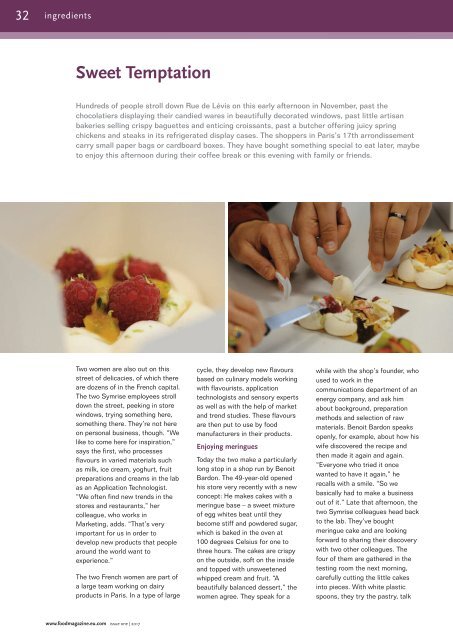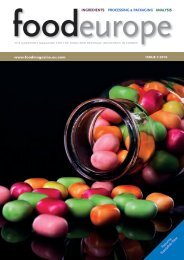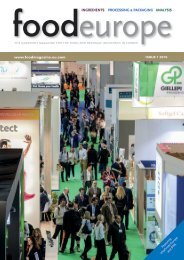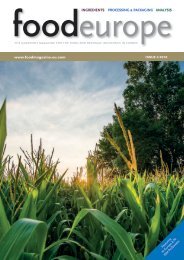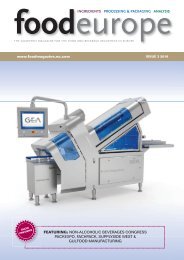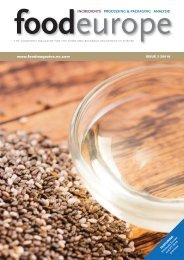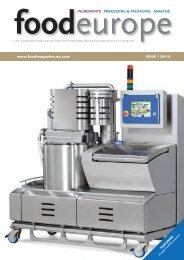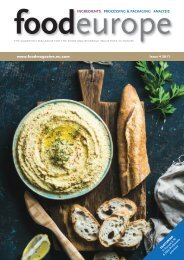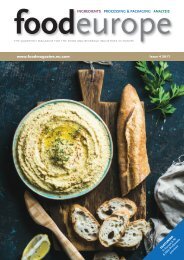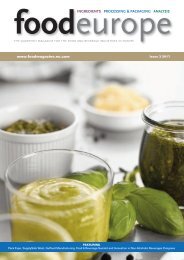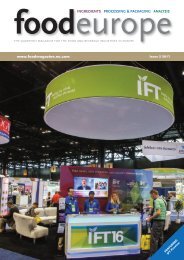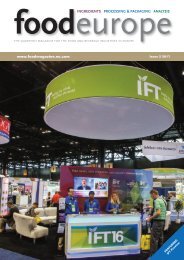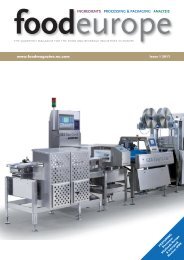issue 1 2017
Issue 1 2017 of FoodEurope Magazine
Issue 1 2017 of FoodEurope Magazine
Create successful ePaper yourself
Turn your PDF publications into a flip-book with our unique Google optimized e-Paper software.
32<br />
ingredients<br />
Sweet Temptation<br />
Hundreds of people stroll down Rue de Lévis on this early afternoon in November, past the<br />
chocolatiers displaying their candied wares in beautifully decorated windows, past little artisan<br />
bakeries selling crispy baguettes and enticing croissants, past a butcher offering juicy spring<br />
chickens and steaks in its refrigerated display cases. The shoppers in Paris’s 17th arrondissement<br />
carry small paper bags or cardboard boxes. They have bought something special to eat later, maybe<br />
to enjoy this afternoon during their coffee break or this evening with family or friends.<br />
Two women are also out on this<br />
street of delicacies, of which there<br />
are dozens of in the French capital.<br />
The two Symrise employees stroll<br />
down the street, peeking in store<br />
windows, trying something here,<br />
something there. They’re not here<br />
on personal business, though. “We<br />
like to come here for inspiration,”<br />
says the first, who processes<br />
flavours in varied materials such<br />
as milk, ice cream, yoghurt, fruit<br />
preparations and creams in the lab<br />
as an Application Technologist.<br />
“We often find new trends in the<br />
stores and restaurants,” her<br />
colleague, who works in<br />
Marketing, adds. “That’s very<br />
important for us in order to<br />
develop new products that people<br />
around the world want to<br />
experience.”<br />
The two French women are part of<br />
a large team working on dairy<br />
products in Paris. In a type of large<br />
cycle, they develop new flavours<br />
based on culinary models working<br />
with flavourists, application<br />
technologists and sensory experts<br />
as well as with the help of market<br />
and trend studies. These flavours<br />
are then put to use by food<br />
manufacturers in their products.<br />
Enjoying meringues<br />
Today the two make a particularly<br />
long stop in a shop run by Benoit<br />
Bardon. The 49-year-old opened<br />
his store very recently with a new<br />
concept: He makes cakes with a<br />
meringue base – a sweet mixture<br />
of egg whites beat until they<br />
become stiff and powdered sugar,<br />
which is baked in the oven at<br />
100 degrees Celsius for one to<br />
three hours. The cakes are crispy<br />
on the outside, soft on the inside<br />
and topped with unsweetened<br />
whipped cream and fruit. “A<br />
beautifully balanced dessert,” the<br />
women agree. They speak for a<br />
while with the shop’s founder, who<br />
used to work in the<br />
communications department of an<br />
energy company, and ask him<br />
about background, preparation<br />
methods and selection of raw<br />
materials. Benoit Bardon speaks<br />
openly, for example, about how his<br />
wife discovered the recipe and<br />
then made it again and again.<br />
“Everyone who tried it once<br />
wanted to have it again,” he<br />
recalls with a smile. “So we<br />
basically had to make a business<br />
out of it.” Late that afternoon, the<br />
two Symrise colleagues head back<br />
to the lab. They’ve bought<br />
meringue cake and are looking<br />
forward to sharing their discovery<br />
with two other colleagues. The<br />
four of them are gathered in the<br />
testing room the next morning,<br />
carefully cutting the little cakes<br />
into pieces. With white plastic<br />
spoons, they try the pastry, talk<br />
www.foodmagazine.eu.com <strong>issue</strong> one | <strong>2017</strong>


